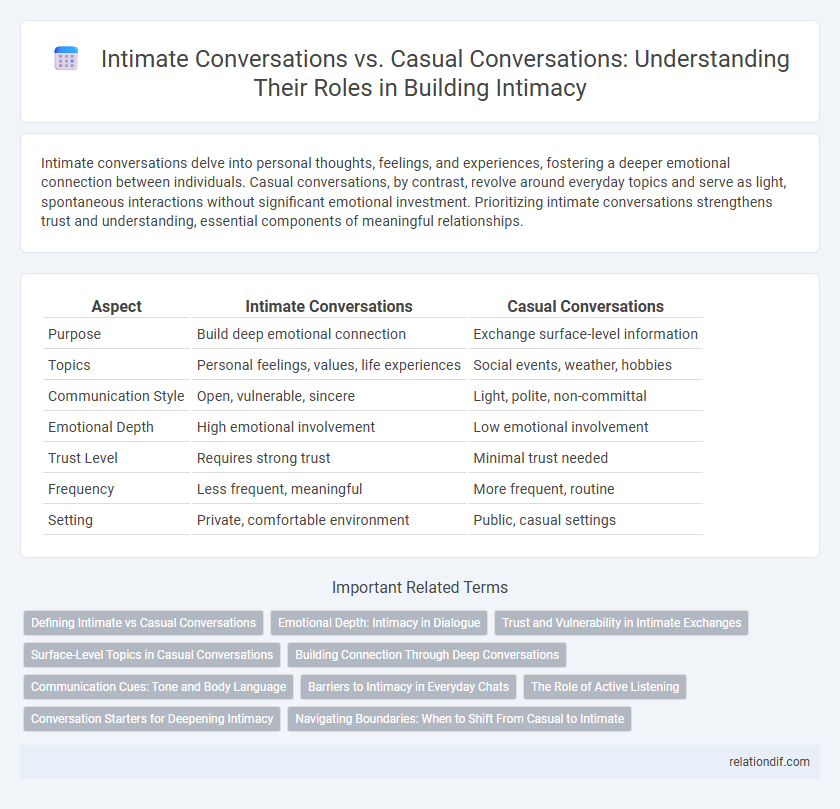Intimate conversations delve into personal thoughts, feelings, and experiences, fostering a deeper emotional connection between individuals. Casual conversations, by contrast, revolve around everyday topics and serve as light, spontaneous interactions without significant emotional investment. Prioritizing intimate conversations strengthens trust and understanding, essential components of meaningful relationships.
Table of Comparison
| Aspect | Intimate Conversations | Casual Conversations |
|---|---|---|
| Purpose | Build deep emotional connection | Exchange surface-level information |
| Topics | Personal feelings, values, life experiences | Social events, weather, hobbies |
| Communication Style | Open, vulnerable, sincere | Light, polite, non-committal |
| Emotional Depth | High emotional involvement | Low emotional involvement |
| Trust Level | Requires strong trust | Minimal trust needed |
| Frequency | Less frequent, meaningful | More frequent, routine |
| Setting | Private, comfortable environment | Public, casual settings |
Defining Intimate vs Casual Conversations
Intimate conversations involve sharing personal thoughts, emotions, and vulnerabilities, fostering a deep sense of trust and connection between participants. Casual conversations, on the other hand, revolve around everyday topics, surface-level interactions, and social pleasantries without requiring emotional exposure. Understanding the distinction lies in recognizing the level of emotional depth and mutual openness present in the dialogue.
Emotional Depth: Intimacy in Dialogue
Intimate conversations reveal emotional depth by encouraging vulnerability and authentic self-expression, fostering stronger connections. Unlike casual conversations that often skim surface topics, these dialogues explore personal feelings, fears, and desires, creating a safe space for trust-building. Engaging in intimate conversations enhances emotional intimacy, essential for deepening relationships and psychological well-being.
Trust and Vulnerability in Intimate Exchanges
Intimate conversations foster deep trust by encouraging vulnerability and genuine emotional sharing, unlike casual conversations that often remain surface-level and guarded. Trust grows as individuals reveal personal experiences and feelings, creating a strong emotional bond that casual exchanges typically do not achieve. Vulnerability in intimate exchanges acts as a foundation for connection, enabling mutual understanding and empathy between participants.
Surface-Level Topics in Casual Conversations
Surface-level topics in casual conversations often include weather, current events, or weekend plans, allowing individuals to engage without revealing personal emotions or vulnerabilities. These subjects create a comfortable environment for social interaction without the risk of emotional exposure. Unlike intimate conversations, casual discussions prioritize small talk and maintain social distance rather than fostering deep emotional connections.
Building Connection Through Deep Conversations
Intimate conversations foster emotional vulnerability and trust by encouraging participants to share personal thoughts and feelings, unlike casual conversations that typically revolve around surface-level topics. Deep conversations activate oxytocin release, strengthening bonds and promoting a sense of safety and understanding between individuals. Prioritizing meaningful dialogue enhances relational satisfaction and supports long-term connection development.
Communication Cues: Tone and Body Language
Intimate conversations rely heavily on subtle communication cues such as soft tones and prolonged eye contact that convey trust and vulnerability, distinguishing them from casual interactions. In intimate settings, body language includes open postures and gentle gestures that foster emotional connection, whereas casual conversations often involve more neutral or distracted nonverbal signals. The alignment of tone and body language in intimate dialogue significantly enhances emotional understanding and deepens relational bonds.
Barriers to Intimacy in Everyday Chats
Intimate conversations reveal personal thoughts and feelings, fostering deep emotional connections, whereas casual conversations remain surface-level and focus on general topics. Barriers to intimacy in everyday chats often include fear of vulnerability, lack of trust, and distractions such as technology or social settings. Overcoming these obstacles requires intentional listening, empathy, and creating a safe space for open, honest dialogue.
The Role of Active Listening
Active listening transforms intimate conversations by creating a safe space for genuine emotional exchange and deeper understanding. Unlike casual conversations, where surface-level topics dominate, intimate dialogues require focused attention, empathy, and validation of feelings to build trust and connection. Mastering active listening enhances intimacy by encouraging vulnerability and strengthening relational bonds.
Conversation Starters for Deepening Intimacy
Intimate conversations require thoughtful conversation starters that encourage vulnerability and emotional sharing, such as asking about personal dreams, fears, or defining life moments. Unlike casual conversations that revolve around surface-level topics, these starters foster trust and deeper connection by inviting openness and active listening. Questions like "What experience has shaped who you are today?" or "What do you value most in relationships?" effectively deepen intimacy through meaningful dialogue.
Navigating Boundaries: When to Shift From Casual to Intimate
Navigating the boundaries between casual and intimate conversations requires attentiveness to emotional cues and context, ensuring both parties feel safe and respected. Intimate conversations often involve sharing personal experiences, vulnerabilities, and deeper feelings, which demands trust and timing to naturally transition from surface-level dialogue. Recognizing moments of openness or reciprocal sharing signals the appropriate time to shift focus and deepen the connection without breaching comfort zones.
Intimate conversations vs casual conversations Infographic

 relationdif.com
relationdif.com